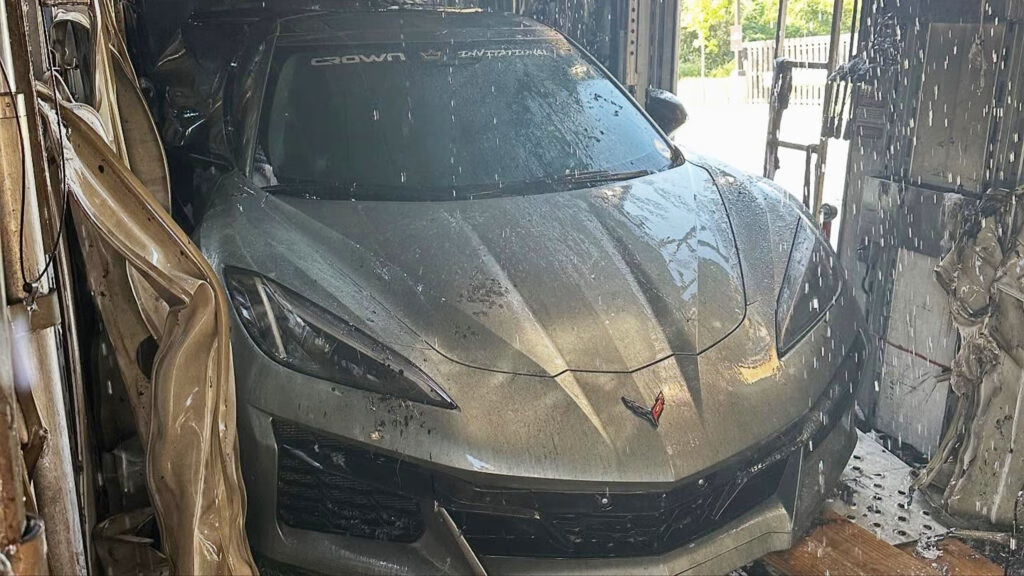How Did a Routine Supercar Transport Turn Into a Million-Dollar Disaster?
Five exotic cars—two McLarens, two Corvette C8s, and an Audi R8—were reduced to charred wreckage in Chattanooga, Tennessee, after a transporter erupted in flames during the Crown Rally, a high-profile event stretching from Boston to Atlanta. The cars were fresh off a track day at Atlanta Motorsports Park, loaded up and headed to their next stop. For the owners, it was supposed to be another thrilling chapter in the rally. Instead, it became a nightmare.
A sharp-eyed motorist first spotted smoke billowing from the trailer and flagged down the truck driver, who immediately pulled into a QuickTrip station and dialed 911. Despite his quick response, emergency crews couldn’t save the precious cargo. By the time firefighters arrived, the trailer was gutted, and only one Corvette was even faintly recognizable. The estimated damage? A staggering $1.5 million.
What Typically Causes Fires in Car Transporters?
While seeing a trailer full of supercars ablaze is rare, fires involving car haulers aren’t unheard of. According to the National Fire Protection Association, vehicle fires account for about 16% of all reported fires in the US, with mechanical failures and electrical malfunctions being the leading culprits. In the case of car carriers, the risks multiply: tightly packed vehicles, potential fuel leaks, electrical systems left on, and the sheer value of the cargo.
Authorities haven’t pinned down the exact cause of the Chattanooga blaze, but early speculation suggests the fire may have started near the center of the trailer, possibly sparked by one of the vehicles. It’s a sobering reminder that even with high-end cars, the basics—fuel, batteries, wiring—can still go wrong in dramatic fashion.
Could This Have Been Prevented? Lessons for Car Enthusiasts and Transporters
Incidents like this raise tough questions for car owners and transport companies alike. Was there a pre-trip inspection? Were all batteries disconnected and fuel levels checked? The best transporters follow strict protocols: disconnecting batteries, ensuring no leaks, and spacing vehicles to prevent contact. But even with precautions, things can slip through the cracks.
A 2023 report from the Insurance Institute for Highway Safety highlights that most car carrier fires start with a single vehicle, often due to a lingering mechanical issue that flares up under the stress of transport. For rally participants and collectors, the lesson is clear: insist on reputable haulers, demand detailed pre-load inspections, and don’t be afraid to ask about emergency procedures. Sometimes, a little paranoia pays off.
What Happens After a Supercar Fire? Insurance, Recovery, and Emotional Fallout
For the owners, the aftermath is more than just paperwork. Yes, comprehensive insurance usually covers fire losses—especially for high-value vehicles—but the claims process can be long and contentious. Insurers will scrutinize maintenance records, transport contracts, and even rally waivers. And let’s be honest: no payout can truly replace a rare McLaren or a meticulously customized Corvette.
There’s also the emotional gut-punch. These cars aren’t just investments; they’re passion projects, rolling memories, and, for many, the highlight of their automotive lives. Losing them in such a dramatic fashion stings in a way that’s hard to quantify.
Are Car Carrier Fires Becoming More Common?
While this Chattanooga incident made headlines due to the value and rarity of the cars involved, transporter fires aren’t exactly spiking nationwide. However, the growing popularity of luxury rallies and track events means more high-end vehicles are on the move than ever before. According to data from the Federal Motor Carrier Safety Administration, the number of car haulers on US roads has increased by nearly 20% over the past five years, and with more traffic comes more risk.
Recent months have seen several high-profile transporter fires, including a semi loaded with new electric vehicles in California. EVs, with their unique battery risks, add another layer of complexity for transporters and emergency crews alike.
What Can Owners and Drivers Do to Protect Their Cars in Transit?
If you’re shipping a prized vehicle, don’t just hand over the keys and hope for the best. Here are a few practical tips:
– Choose a transporter with a stellar safety record and transparent protocols.
– Ask about fire suppression systems—some modern trailers are equipped with automatic extinguishers.
– Ensure all vehicles are properly prepped: batteries disconnected, fuel at a safe level, and no loose items inside.
– Request regular status updates, especially on long hauls.
– Double-check your insurance coverage for transport-specific scenarios.
And if you’re a driver, stay alert. The Chattanooga fire was caught early thanks to a vigilant motorist. Sometimes, it’s the little things—a glance in the mirror, a whiff of smoke—that make all the difference.
Why Do These Stories Capture Our Attention?
There’s something uniquely gut-wrenching about seeing a collection of supercars—symbols of speed, engineering, and aspiration—reduced to ashes. It’s not just about the money. It’s about the dreams those cars represent, the communities that rally around them, and the reminder that even the rarest machines are vulnerable.
The big takeaway? Protecting your prized car isn’t about perfection—it’s about smarter adjustments. Start with one change this week, and you’ll likely spot the difference by month’s end.

